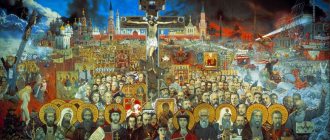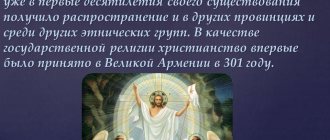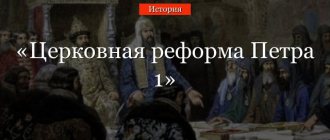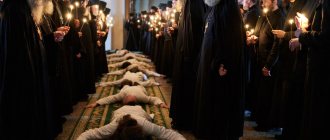Until 1054, the Christian Church was one and indivisible. The schism occurred due to disagreements between Pope Leo IX and the Patriarch of Constantinople, Michael Cyroularius. The conflict began due to the closing of several Latin churches by the latter in 1053. For this, the papal legates excommunicated Kirularius from the Church. In response, the patriarch anathematized the papal envoys. In 1965, the mutual curses were lifted. However, the schism of the Churches has not yet been overcome. Christianity is divided into three main directions: Orthodoxy, Catholicism and Protestantism.
Eastern Church
The difference between Orthodoxy and Catholicism, since both of these religions are Christian, is not very significant. However, there are still some differences in teaching, performance of sacraments, etc. We'll talk about which ones a little later. First, let's make a short overview of the main directions of Christianity.
Orthodoxy, called the orthodox religion in the West, is currently practiced by about 200 million people. Approximately 5 thousand people are baptized every day. This direction of Christianity spread mainly in Russia, as well as in some CIS countries and Eastern Europe.
The baptism of Rus' took place at the end of the 9th century on the initiative of Prince Vladimir. The ruler of a huge pagan state expressed a desire to marry the daughter of the Byzantine Emperor Vasily II, Anna. But for this he needed to convert to Christianity. An alliance with Byzantium was extremely necessary to strengthen the authority of Rus'. At the end of the summer of 988, a huge number of Kiev residents were baptized in the waters of the Dnieper.
Catholic Church
As a result of the schism in 1054, a separate denomination arose in Western Europe. Representatives of the Eastern Church called her “Catholicos”. Translated from Greek it means “universal”. The difference between Orthodoxy and Catholicism lies not only in the approach of these two Churches to some dogmas of Christianity, but also in the history of development itself. The Western confession, compared to the Eastern one, is considered much more rigid and fanatical.
One of the most important milestones in the history of Catholicism was, for example, the Crusades, which brought a lot of grief to the common population. The first of them was organized at the call of Pope Urban II in 1095. The last - the eighth - ended in 1270. The official goal of all crusades was the liberation of the “holy land” of Palestine and the “Holy Sepulcher” from the infidels. The actual one was the conquest of lands that belonged to Muslims.
In 1229, Pope George IX issued a decree establishing the Inquisition - a church court for apostates from the faith. Torture and burning at the stake - this is how extreme Catholic fanaticism was expressed in the Middle Ages. In total, during the existence of the Inquisition, more than 500 thousand people were tortured.
Of course, the difference between Catholicism and Orthodoxy (this will be discussed briefly in the article) is a very large and deep topic. However, in general terms, its traditions and basic concept can be understood in relation to the Church’s relationship with the population. The Western confession has always been considered more dynamic, but also aggressive, in contrast to the “calm” Orthodox one.
Currently, Catholicism is the state religion in most European and Latin American countries. More than half of all (1.2 billion people) modern Christians profess this particular religion.
Protestantism
The difference between Orthodoxy and Catholicism also lies in the fact that the former has remained united and indivisible for almost a millennium. In the Catholic Church in the 14th century. a split occurred. This was connected with the Reformation, a revolutionary movement that arose at that time in Europe. In 1526, at the request of German Lutherans, the Swiss Reichstag issued a decree on the right of free choice of religion for citizens. In 1529, however, it was abolished. As a result, a protest followed from a number of cities and princes. This is where the word “Protestantism” comes from. This Christian movement is further divided into two branches: early and late.
At the moment, Protestantism is widespread mainly in the Scandinavian countries: Canada, USA, England, Switzerland, and the Netherlands. In 1948, the World Council of Churches was created. The total number of Protestants is about 470 million people. There are several denominations of this Christian movement: Baptists, Anglicans, Lutherans, Methodists, Calvinists.
In our time, the World Council of Protestant Churches pursues an active peacemaking policy. Representatives of this religion advocate easing international tension, support the efforts of states to defend peace, etc.
History of the origin of Lutheranism
The history of Lutheranism began in 1517 in Germany with the Protestant movement. A Catholic theologian named Martin Luther decided to cleanse the religion of dogmatic errors, and therefore was declared a heretic. He later became a reformer, but first he was forced to hide in Wartburg Castle in Eisenach under the name Georg Juncker, where he translated the New Testament into German. Later in Lutheranism it became known as Luther's Bible. In 1529, Protestantism officially became a movement of Catholicism after twenty signatures were added to the Speyer Protest. It was a protest of fourteen cities of the Roman Empire and six princes. But just six months later, at a debate in the city of Marburg, differences arose between Luther and Ulrich Zwingli, which led to a split in the Protestant camp into Lutheranism and Calvinism.
This will be followed by the death of Martin Luther and the Schmalkalden War, in which the Lutherans will be defeated. They will receive legalization only in 1555 thanks to the Religious Peace of Augsburg. This agreement allowed representatives of the imperial classes to independently choose their religion and recognized Lutheranism as a religion in the territory of the Holy Roman Empire.
The difference between Orthodoxy and Catholicism and Protestantism
Of course, over the centuries of schism, significant differences have arisen in the traditions of the churches.
They did not touch upon the basic principle of Christianity - accepting Jesus as the Savior and Son of God. However, in relation to certain events of the New and Old Testaments, there are often even mutually exclusive differences. In some cases, the methods of conducting various kinds of rituals and sacraments do not agree. The main differences between Orthodoxy and Catholicism and Protestantism
| Orthodoxy | Catholicism | Protestantism | |||
| Control | Patriarch, Cathedral | Dad | World Council of Churches, councils of bishops | ||
| Organization | Bishops depend little on the Patriarch and are mainly subordinate to the Council | There is a rigid hierarchy with subordination to the Pope, hence the name “Universal Church” | There are many denominations that have created the World Council of Churches. Sacred Scripture is placed above the authority of the Pope | ||
| Holy Spirit | It is believed that it comes only from the Father | There is a dogma that the Holy Spirit comes from both the Father and the Son. This is the main difference between Orthodoxy and Catholicism and Protestantism. | |||
| God the Father | The statement is accepted that man himself is responsible for his sins, and God the Father is a completely impassive and abstract being | It is believed that God suffers because of human sins | |||
| Dogma of Salvation | The Crucifixion atoned for all the sins of mankind. Only the firstborn remained. That is, when a person commits a new sin, he again becomes the object of God’s wrath | The person was, as it were, “ransomed” by Christ through the crucifixion. As a result, God the Father changed his anger to mercy regarding original sin. That is, a person is holy by the holiness of Christ himself | |||
| Divorces | Sometimes allowed | Prohibited | Allowed, but frowned upon | ||
| Immaculate Conception of the Virgin Mary | It is believed that the Mother of God is not free from original sin, but her holiness is recognized | The complete sinlessness of the Virgin Mary is preached. Catholics believe that she was conceived immaculately, like Christ himself. In relation to the original sin of the Mother of God, therefore, there are also quite significant differences between Orthodoxy and Catholicism | Absolutely not accepted | ||
| Assumption of the Virgin Mary into Heaven | It is unofficially believed that this event may have taken place, but it is not enshrined in dogma | The assumption of the Mother of God into heaven in a physical body is a dogma | The cult of the Virgin Mary is denied | ||
| Ritual | Only liturgy is held | Both a mass and a Byzantine liturgy similar to the Orthodox can be celebrated | The mass was rejected. Divine services are held in modest churches or even in stadiums, concert halls, etc. Only two rites are practiced: baptism and communion | ||
| Clergy marriage | Allowed | Allowed only in the Byzantine rite | Allowed | ||
| Ecumenical Councils | The decisions of the first seven | Guided by 21 decisions (the last one passed in 1962-1965) | Recognize the decisions of all Ecumenical Councils if they do not contradict each other and the Holy Scriptures | ||
| Cross | Eight-pointed with crossbars at the bottom and top | A simple four-pointed Latin cross is used | Not used in religious services. Not worn by representatives of all faiths | ||
| Icons | Used in large quantities and equated with Holy Scripture. Created in strict accordance with church canons | They are considered only decoration of the temple. They are ordinary paintings on a religious theme | Not used | ||
| Old Testament | Both Hebrew and Greek are recognized | Greek only | Only Jewish canonical | ||
| Absolution | The ritual is performed by a priest | Not allowed | |||
| Science and religion | Based on the statements of scientists, dogmas never change | Dogmas can be adjusted in accordance with the point of view of official science | |||
Basic Protestant Principles
The question of who Protestants are can be answered by understanding the basic principles of their teaching. Protestants consider all the rich church experience, all the spiritual art collected over the centuries, to be invalid. They recognize only the Bible, believing that it is the only true source of how and what to do in church life. For Protestants, the Christian communities of the time of Jesus and his apostles are the ideal of what the life of a Christian should be. But adherents of Protestantism do not take into account the fact that at that time the church structure simply did not exist. Protestants simplified everything in the Church except the Bible, mainly due to the reforms of the Roman Church. Because Catholicism has greatly changed its teachings and deviated from the Christian spirit. And schisms among Protestants began to occur because they rejected everything - even the teachings of great saints, spiritual teachers, and leaders of the Church. And since Protestants began to deny these teachings, or rather, did not accept them, they began to have disputes in the interpretation of the Bible. Hence the split in Protestantism and the waste of energy not on self-education, like the Orthodox, but on a useless struggle. The difference between Catholics and Protestants is erased against the background of the fact that the Orthodox, who have kept their faith in the form in which Jesus transmitted it for more than 2000 years, are called a mutation of Christianity by both. Both Catholics and Protestants are confident that their faith is the true one, the way Christ intended it.
Christian cross: differences
Disagreements regarding the descent of the Holy Spirit are the main difference between Orthodoxy and Catholicism. The table also shows many other, albeit not very significant, but still discrepancies. They arose a long time ago, and, apparently, none of the churches expresses any particular desire to resolve these contradictions.
There are also differences in the attributes of different directions of Christianity. For example, the Catholic cross has a simple quadrangular shape. The Orthodox have eight points. The Orthodox Eastern Church believes that this type of crucifix most accurately conveys the shape of the cross described in the New Testament. In addition to the main horizontal crossbar, it contains two more. The top one represents a tablet nailed to the cross and containing the inscription “Jesus of Nazareth, King of the Jews.” The lower oblique crossbar - a support for Christ's feet - symbolizes the “righteous standard”.
Table of differences between crosses
The image of the Savior on the crucifix used in the Sacraments is also something that can be attributed to the topic “the difference between Orthodoxy and Catholicism.”
The western cross is a little different from the eastern one. Differences between crosses
| Orthodox | Catholic |
| Eight- or six-pointed | Four-pointed |
| Christ is depicted alive, having conquered death | The bas-relief of Jesus is naturalistic. Sometimes even streams of blood can be depicted |
| The words on the top plate are written in Slavic-Russian | Words INRI - in Latin |
| Jesus' feet are positioned separately. Each one of them is nailed to a crucifix | Legs put together and nailed with one nail |
As you can see, with regard to the cross there is also a very noticeable difference between Orthodoxy and Catholicism. The table shows this clearly.
As for Protestants, they consider the cross to be a symbol of the Pope, and therefore practically do not use it.
Icons in different Christian directions
So, the difference between Orthodoxy and Catholicism and Protestantism (the table of comparisons of crosses confirms this) with regard to attributes is quite noticeable. There are even greater differences in these directions in icons. The rules for depicting Christ, the Mother of God, saints, etc. may differ.
Below are the main differences.
Differences in icons
| Orthodox | Catholic | |
| Hands of the saints | The right one lies on top of the left one | Left over right |
| Eyes | Humbly covered | "Surprised" look |
| Robe of the Virgin Mary | Bright, golden | Black robe over white |
| Signatures | In most cases there are no | In Latin |
The main difference between an Orthodox icon and a Catholic one is that it is painted in strict accordance with the canons established in Byzantium. Western images of saints, Christ, etc., strictly speaking, have nothing to do with the icon. Typically, such paintings have a very broad subject and were painted by ordinary, non-church artists.
Protestants consider icons to be a pagan attribute and do not use them at all.
The schism of Protestantism and its consequences
When discussing the question of what Lutheranism is, one cannot help but touch upon the history of Calvinism. In essence, both directions stem from the reform movement of Martin Luther, but Calvinism first identified itself at the debate in the city of Marburg, which is mentioned above. This dispute split the Reformed Protestants into two camps - German Protestants and Swiss Protestants.
Despite the fact that Calvinism got its name from John Calvin, the schism was allowed through the efforts of Ulrich Zwingli, who had a dispute with Martin Luther himself. The dispute centered on the formality of the rite of communion, which Zwingli insisted on, which was one of the main ideas of the reforms of Catholicism. Luther insisted on maintaining the sacrament as the main sacrament.
After the death of Zwingli, his work was continued by the French theologian John Calvin. Calvin is considered a true reformer, from whom the true movement, Calvinism, originated. The differences between Lutheranism and Calvinism are quite significant if you look at these directions today, after centuries. Earlier, when the founders were motivated by ideas of reformism, the differences seemed even more serious.
Monasticism
With regard to leaving worldly life and devoting oneself to serving God, there is also a significant difference between Orthodoxy and Catholicism and Protestantism. The comparison table above shows only the main differences. But there are other differences, also quite noticeable.
For example, in our country, each monastery is practically autonomous and subordinate only to its own bishop. Catholics have a different organization in this regard. The monasteries are united into so-called Orders, each of which has its own head and its own charter. These associations may be scattered throughout the world, but nevertheless they always have a common leadership.
Protestants, unlike Orthodox and Catholics, completely reject monasticism. One of the inspirers of this teaching, Luther, even married a nun.
Features of Lutheranism
The principles of Lutheranism are based on the Book of Concord, written in 1580. The total number of Lutherans worldwide today is approximately 85 million. This relatively small number is divided internally into several different movements and churches. The main feature of Lutheranism is the absence of a single church and integrity.
Difficulties in the formation of a unified church were marked by geographical, dogmatic and historical reasons.
According to the Book of Concord, Lutheranism recognizes three creeds:
- Nicene.
- Afanasyevsky.
- Apostolic.
However, not all Lutherans accept the Book of Concord as a unified theory. Today, liberal movements in Lutheranism are quite common, which allow people not to attend services.
Church Sacraments
There is a difference between Orthodoxy and Catholicism in relation to the rules for conducting various kinds of rituals. Both of these Churches have 7 sacraments. The difference lies primarily in the meaning attached to the main Christian rituals. Catholics believe that the sacraments are valid whether a person is in tune with them or not. According to the Orthodox Church, baptism, confirmation, etc. will be effective only for believers who are completely disposed towards them. Orthodox priests even often compare Catholic rituals with some kind of pagan magical ritual that operates regardless of whether a person believes in God or not.
The Protestant Church practices only two sacraments: baptism and communion. Representatives of this trend consider everything else superficial and reject it.
Baptism
This main Christian sacrament is recognized by all churches: Orthodoxy, Catholicism, Protestantism. The only differences are in the methods of performing the ritual.
In Catholicism, it is customary for infants to be sprinkled or doused. According to the dogmas of the Orthodox Church, children are completely immersed in water. Recently there has been some movement away from this rule. However, now the Russian Orthodox Church is again returning in this rite to the ancient traditions established by Byzantine priests.
The difference between Orthodoxy and Catholicism (crosses worn on the body, like large ones, may contain the image of an “orthodox” or “Western” Christ) in relation to the performance of this sacrament is therefore not very significant, but it still exists.
Protestants usually perform baptism with water. But in some denominations it is not used. The main difference between Protestant baptism and Orthodox and Catholic baptism is that it is carried out exclusively for adults.
Catholics
Find out what awaits you today - Horoscope for today for all zodiac signs
The so-called Western Rite Church.
- The Pope is considered their head. Their church is one.
- Priests (exclusively men) do not marry; they devote their entire lives only to serving the Lord. Beards are not traditionally worn.
- Condemns homosexual relations.
- There are monasteries and monastic orders in this church.
- Children are baptized from infancy.
- Cross themselves: from right to left.
- They confess to the priest, believing that this should be done at least once a year.
- They venerate saints, icons, and relics of the righteous.
- They believe in heaven, hell and purgatory.
Differences in the Sacrament of the Eucharist
We have examined the main differences between Orthodoxy and Catholicism. This refers to the descent of the Holy Spirit and the virginity of the birth of the Virgin Mary. Such significant differences have emerged over centuries of schism. Of course, they also exist in the celebration of one of the main Christian sacraments - the Eucharist. Catholic priests administer communion only with unleavened bread. This church product is called wafers. In Orthodoxy, the sacrament of the Eucharist is celebrated with wine and ordinary yeast bread.
In Protestantism, not only members of the Church, but also anyone who wishes, are allowed to receive communion. Representatives of this direction of Christianity celebrate the Eucharist in the same way as the Orthodox - with wine and bread.
About Lutheranism and Calvinism today
Lutheranism today is one of the most liberal religious movements, where there is no monasticism, but there is an ordination of females. The confessional direction of Lutheranism continues to this day to debate its attitude towards this issue, as well as the issue of same-sex marriage, but all disputes with the liberal movement are limited to just conversations.
Calvinism today remains a fairly strict religion. True believers do not honor any holidays except Sunday; they pray in simple churches and even on the street. Many people condemn Calvinism for being too simple.
Modern relations of the Churches
The split in Christianity occurred almost a thousand years ago. And during this time, churches of different directions failed to agree on unification. Disagreements regarding the interpretation of Holy Scripture, attributes and rituals, as you can see, have persisted to this day and have even intensified over the centuries.
The relations between the two main faiths, Orthodox and Catholic, are also quite ambiguous in our time. Until the middle of the last century, serious tension remained between these two churches. The key concept in the relationship was the word “heresy.”
Recently this situation has changed a little. If earlier the Catholic Church considered Orthodox Christians almost a bunch of heretics and schismatics, then after the Second Vatican Council it recognized the orthodox Sacraments as valid.
Orthodox priests did not officially establish a similar attitude towards Catholicism. But the completely loyal acceptance of Western Christianity has always been traditional for our church. However, of course, some tension between Christian directions still remains. For example, our Russian theologian A.I. Osipov does not have a very good attitude towards Catholicism.
In his opinion, there is a more than worthy and serious difference between Orthodoxy and Catholicism. Osipov considers many saints of the Western Church to be almost crazy. He also warns the Russian Orthodox Church that, for example, cooperation with Catholics threatens the Orthodox with complete subjugation. However, he also repeatedly mentioned that there are wonderful people among Western Christians.
Thus, the main difference between Orthodoxy and Catholicism is the attitude towards the Trinity. The Eastern Church believes that the Holy Spirit comes only from the Father. Western - both from the Father and from the Son. There are other differences between these faiths. However, in any case, both churches are Christian and accept Jesus as the Savior of mankind, whose coming, and therefore Eternal life for the righteous, is inevitable.
What else do Protestants lack?
It is not for nothing that many people do not understand who Protestants are. After all, people of this religion, as mentioned above, do not have spiritual literature, such as Orthodox Christians. In the spiritual books of the Orthodox you can find almost everything - from sermons and interpretation of the Bible to the lives of saints and advice on how to fight your passions. It becomes much easier for a person to understand issues of good and evil. And without an interpretation of the Holy Scriptures, it is extremely difficult to understand the Bible. Spiritual literature began to appear among Protestants, but it is still in its infancy, while in Orthodoxy this literature has been perfected for more than 2000 years. Self-education, self-improvement are concepts inherent in every Orthodox Christian; among Protestants they come down to studying and memorizing the Bible. In Orthodoxy, everything - repentance, confession, communion, prayers, and icons - everything calls for a person to strive at least one step closer to the ideal that God is. But a Protestant directs all his efforts to being virtuous outwardly, and does not care about his inner content. That's not all. Protestants and Orthodox Christians notice differences in religion by the arrangement of churches. An Orthodox believer has support in striving to be better both in mind (thanks to preaching), and in heart (thanks to decoration in churches, icons), and will (thanks to fasting). But Protestant churches are empty and Protestants hear only sermons that influence the mind without touching the hearts of people. Having abandoned monasteries and monasticism, Protestants lost the opportunity to see for themselves examples of a modest, humble life for the sake of the Lord. After all, monasticism is a school of spiritual life. It is not for nothing that among the monks there are many elders, saints or almost saints of Orthodox Christians. And also the concept of Protestants that nothing other than faith in Christ is needed for salvation (neither good deeds, nor repentance, nor self-correction) is a false path that leads only to the addition of another sin - pride (due to the feeling that If you are a believer, then you are the chosen one and will certainly be saved).








